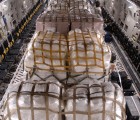The convergence of agreements on disaster risk reduction (DRR), development finance, sustainable development and climate change in 2015 presents a unique opportunity for coherence across these inter-related policy areas. At the same time, demand is growing for a more prominent and effective role for science and technology in providing evidence for policy, with the international community recognising that successful disaster risk reduction (DRR) depends on it. Reflecting this ambition, science is included as a core aspect of the Sendai Framework for Disaster Risk Reduction 2015-2030, although the ways in which this will be implemented in practice is still unclear. This paper aims to inform the implementation of international science coordination for DRR by examining a number of existing international science partnerships used across other relevant areas of policy to understand best practice, options for coordination and lessons identified. In the field of DRR, the science-policy interface needs to be strengthened in line with the best practice described in this review. An enhanced UNISDR Scientific and Technical Advisory Group will be given the mandate for to enhance the evidence base for DRR and mobilise science and technical work in coordination with a broad range of stakeholders. The structure and function of an enhanced STAG must be as open, as inclusive and as participatory as possible in order to build trust in new and existing institutions at local, national, regional and global levels. The challenge for the international community is to facilitate evidence-based policy making by formally recognising the links between DRR, development finance, sustainable development and climate change in the upcoming post-2015 agreements.
Background and purpose: Geoinformatics technology retains an unprecedented trait of performing with a supersonic speed and precision in public health management whereas the existing disease surveillance systems in developing countries lack using this technology. This article aims to assess the feasibility of using geoinformatics technology in disaster disease surveillance in a developing country, Iran.
Methods: A self-administered questionnaire was developed based on technology acceptance model (TAM), and a semi-quantitative survey was conducted in order to collect data. Fifty TUMS & HS personnel, currently involve in disease surveillance and information technology, were included. Initially, a pilot study was conducted to test the validity and reliability of the questionnaire. Cronbach alpha, confirmatory factor analysis (CFA), and standard error of measurement (SEM) were calculated to validate the causal model.
Results: The results from structural equation analysis suggested that TAM provided a constructive picture of using geoinformatics technology in disaster disease surveillance at TUMS &HS. The study found attitude (ATT) had a significant influence on participants intention to use (ITU) a new technology, and perceived ease of use (PEOU) was a strong determinant of perceived of usefulness (PU). Subsequently, PU and PEOU explained ATT substantially; even though the analysis showed insignificant statistical association among these constructs. The high R2 (Coefficient of determination) of the constructs described respondents positive instinct towards accepting a new technology.
Conclusion: The study reveals that personnel intent to adopt geoinformatics technology in disaster disease surveillance; and at the same time, they possess a positive attitude towards the technology. This study also found PEOU has a strong influence on PU, so information sessions and training on geoinformatics technology need to focus primarily on the applications and impacts of technology on disaster disease surveillance.
The health risks posed by heatwaves have been well documented. In the UK, before and during a heatwave, alerts are issued to the general public based on a tiered warning system integrating the use of colour and number sequences. There has of yet been no formal assessment of the public response to these messages. Cultural and language barriers make some members of ethnic minority communities particularly hard to reach. These may be less challenging amongst younger community members, who may be well placed to instigate the circulation of warning information to those less able or willing to use conventional channels.
This qualitative study assesses the role of age and ethnic and cultural background in the conceptualisation of the number and colour systems used as part of the Heat-Health Watch System (HHWS) and the National Severe Weather Warning Service (NSWWS). Young and older participants were recruited from the Bangladeshi and white British populations of Tower Hamlets. All participants were given a cognitive task that required them to identify and draw associations between 12 cards depicting the four colours and numbers used in the warning system and four pictures providing contextualisation in terms of heatwave risk. A qualitative analysis of the heuristics used in the group discussions provided insights into the conceptualisations basic to interpreting colour and number sequences as representations of risk graduations, and how interpretation might be influenced by age and ethnic and cultural background.
There were considerable differences in the interpretation of young Bangladeshi and older white British participants, on the one hand, and older Bangladeshi participants, on the other. Young Bangladeshis and older white British participants conceptualised the colours and numbers as a vertical scale, with the numbers/colours at “the top” corresponding to representations of higher temperature. This conceptualisation was mainly based on strong associations between colour and temperature, with risk only associated with the upper limit of the scale. Older Bangladeshi participants, on the other hand, conceptualised the numbers and pictures as a narrative sequence and disassociated the colours from the other cards. The differences between groups suggest potential cultural barriers to the “intended” interpretation of the colour and number sequences for older Bangladeshis but not for young Bangladeshis. The fact that the predominant association for the colour sequence for both young Bangladeshis and older white British participants was with graduations of temperature rather than risk raises questions about the applicability of using colours in a tiered warning system.
Background: Mass gatherings including a large number of people makes the planning and management of the event a difficult task. Kumbh Mela is one such, internationally famous religious mass gathering. It creates the substantial challenge of creating a temporary city in which millions of people can stay for a defined period of time. The arrangements need to allow this very large number of people to reside with proper human waste disposal, medical services, adequate supplies of food and clean water, transportation etc.
Methods: We report a case study of Maha Kumbh, 2013 which focuses on the management and planning that went into the preparation of Kumbh Mela and understanding its water, sanitation and hygiene conditions. It was an observational cross-sectional study, the field work was done for 13 days, from 21 January to 2 February 2013.
Results: Our findings suggest that the Mela committee and all other agencies involved in Mela management proved to be successful in supervising the event and making it convenient, efficient and safe. Health care services and water sanitation and hygiene conditions were found to be satisfactory. BhuleBhatke Kendra (Center for helping people who got separated from their families) had the major task of finding missing people and helping them to meet their families. Some of the shortfalls identified were that drainage was a major problem and some fire incidents were reported. Therefore, improvement in drainage facilities and reduction in fire incidents are essential to making Mela cleaner and safer. The number of persons per toilet was high and there were no separate toilets for males and females. Special facilities and separate toilets for men and women will improve their stay in Mela.
Conclusion: Inculcation of modern methods and technologies are likely to help in supporting crowd management and improving water, sanitation and hygiene conditions in the continuously expanding KumbhMela, in the coming years.
Introduction: Recent years have witnessed community disaster resilience becoming one of the most heavily supported and advocated approach to disaster risk management. However, its application has been influenced by the lack of assessment tools. This study reviews studies conducted using the resilience concept and examines the tools, models, and methods adopted. It examines the domains, indicators, and indices have been considered in the tools. It provides a critical analysis of the assessment tools available for evaluating community disaster resilience (CDR).
Methods: We investigated international electronic databases including Scopus, MEDLINE through PubMed, ISI Web of Science, Cochrane Library, Cumulative Index to Nursing and Allied Health (CINAHL), and Google Scholar with no limitation on date, and type of articles. The search terms and strategy were as follow: (Disaster* OR Emergenc*) AND (Resilience OR Resilient OR Resiliency) that were applied for titles, abstracts and keywords. Extracted data were analyzed in terms of studied hazards, types of methodology, domains, and indicators of CDR assessment.
Results: Of 675 publications initially identified, the final analysis was conducted on 17 full text articles. These studies presented ten models, tools, or indices for CDR assessment. These evinced a diverse set of models with regard to the domains, indicators and the kind of hazard described. Considerable inter dependency between and among domains and indicators also emerged from this analysis.
Conclusion: The disparity between the articles using the resilience concept and those that offer some approach to measurement (675 vs. 17) indicates the conceptual and measurement complexity in CDR and the fact that the concept may be being used without regard to how CDR should be operationalized and assessed. Of those that have attempted to assess CDR, the level of conceptual diversity indicates limited agreement about how to operationalize the concept. As a way forward we summarize the models identified in the literature and suggest that, as a starting point for the systematic operationalization of CDR, that existing indicators of community disaster resilience be classified in five domains. These are social, economic, institutional, physical and natural domains. A need to use appropriate and effective methods to quantify and weigh them with regard to their relative contributions to resilience is identified, as is a need to consider how these levels interrelate to influence resilience. Although assessment of disaster resilience especially at the community level will inform disaster risk reduction strategies, attempts to systematically do so are in preliminary phases. Further empirical investigation is needed to develop a operational and measurable CDR model.
Introduction: Effectiveness of hospital management of disasters requires a well-defined and rehearsed system. The Hospital Incident Command System (HICS), as a standardized method for command and control, was established in Iranian hospitals, but it has performed fairly during disaster exercises. This paper describes the process for, and modifications to HICS undertaken to optimize disaster management in hospitals in Iran. Methods: In 2013, a group of 11 subject matter experts participated in an expert consensus modified Delphi to develop modifications to the 2006 version of HICS. Results: The following changes were recommended by the expert panel and subsequently implemented: 1) A Quality Control Officer was added to the Command group; 2) Security was defined as a new section; 3) Infrastructure and Business Continuity Branches were moved from the Operations Section to the Logistics and the Administration Sections, respectively; and 4) the Planning Section was merged within the Finance/Administration Section. Conclusion: An expert consensus group developed a modified HICS that is more feasible to implement given the managerial organization of hospitals in Iran. This new model may enhance hospital performance in managing disasters. Additional studies are needed to test the feasibility and efficacy of the modified HICS in Iran, both during simulations and actual disasters. This process may be a useful model for other countries desiring to improve disaster incident management systems for their hospitals.
Background: Surgical capacity assessments in low-income countries have demonstrated critical deficiencies. Though vital for planning capacity improvements, these assessments are resource intensive and impractical during the planning phase of a humanitarian crisis. This study aimed to determine cesarean sections to total operations performed (CSR) and emergency herniorrhaphies to all herniorrhaphies performed (EHR) ratios from Médecins Sans Frontières Operations Centre Brussels (MSF-OCB) projects and examine if these established metrics are useful proxies for surgical capacity in low-income countries affected by crisis.
Methods: All procedures performed in MSF-OCB operating theatres from July 2008 through June 2014 were reviewed. Projects providing only specialty care, not fully operational or not offering elective surgeries were excluded. Annual CSRs and EHRs were calculated for each project. Their relationship was assessed with linear regression.
Results: After applying the exclusion criteria, there were 47,472 cases performed at 13 sites in 8 countries. There were 13,939 CS performed (29% of total cases). Of the 4,632 herniorrhaphies performed (10% of total cases), 30% were emergency procedures. CSRs ranged from 0.06 to 0.65 and EHRs ranged from 0.03 to 1.0. Linear regression of annual ratios at each project did not demonstrate statistical evidence for the CSR to predict EHR [F(2,30)=2.34, p=0.11, R2=0.11]. The regression equation was: EHR = 0.25 + 0.52(CSR) + 0.10(reason for MSF-OCB assistance).
Conclusion: Surgical humanitarian assistance projects operate in areas with critical surgical capacity deficiencies that are further disrupted by crisis. Rapid, accurate assessments of surgical capacity are necessary to plan cost- and clinically-effective humanitarian responses to baseline and acute unmet surgical needs in LICs affected by crisis. Though CSR and EHR may meet these criteria in ‘steady-state’ healthcare systems, they may not be useful during humanitarian emergencies. Further study of the relationship between direct surgical capacity improvements and these ratios is necessary to document their role in humanitarian settings.
Notice of Correction 27 March 2015: PLOS Currents -. Correction: Correction: Challenges for Resuming Normal Life After Earthquake: A Qualitative Study on Rural Areas of Iran. PLOS Currents Disasters. 2015 Mar 27. Edition 1. doi: 10.1371/currents.dis.7c5047fd650abcb2339d1af7782a3066. View correction. Correction There are errors in the author affiliations. The affiliations should appear as shown here: Fardin Alipour1, […]
Between April and June 2014, International Orthodox Christian Charities (IOCC), an International NGO, and the Greek Orthodox Patriarchate of Antioch and All the East (GOPA) conducted a needs assessment of Syrians affected by the crisis with the objective of gaining a better understanding of humanitarian needs and assistance priorities. Findings suggest that interventions that increase access to non-food items, food, medication and education should be prioritized where cost was the primary barrier to accessing goods and services. Cash transfer programs and direct provision of material assistance should be considered, though the most appropriate assistance modality is likely to vary by sector, location and the preferences and prior experience of donors and implementing organizations. Renewed international commitment to funding humanitarian assistance efforts in Syria and neighboring countries where the burden of refugees is greatest is essential from both a human rights perspective and in terms of maintaining stability in the region.
On June 2, 2014 a sandstorm hit Tehran, the capital city of Iran which killed 5 and injured 44 people. The early warning system did not operate properly and the alarm was not transferred to at risk population and the related organizations in time and in a right manner. Additionally, people who were exposed to the winds didn’t know the appropriate safety measures. Focusing much more on establishing EWS to alert the risk prone population timely and public education for taking safety measures when exposed to the disastrous situation is recommended.





